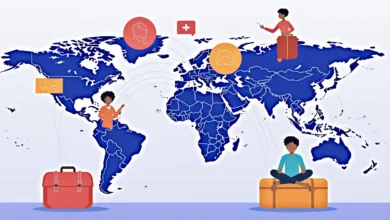USA Immigration Guide: Requirements & Top Mistakes to Avoid 2025

Planning your USA immigration journey? You’re not alone. Every year, millions of people dream of starting a new life in America, but navigating the complex immigration system can feel overwhelming. As someone who’s helped countless individuals through this process, I’m here to break down everything you need to know about USA immigration requirements and help you avoid the costly mistakes that derail many applications.
Whether you’re a student dreaming of studying at an American university, a professional seeking better career opportunities, or a family wanting to reunite with loved ones, this guide will give you the roadmap you need. Let’s dive into the world of American immigration together – think of me as your friend who’s been through this journey and wants to share what really works.
Table of Contents
Understanding USA Immigration: Your Foundation for Success
USA immigration isn’t just about filling out forms and hoping for the best. It’s a strategic process that requires careful planning, attention to detail, and understanding of the system. The United States offers multiple pathways to legal immigration, each with its own requirements, timelines, and challenges.
The key to successful USA immigration lies in choosing the right path for your situation and avoiding common pitfalls that can delay or even destroy your dreams. According to recent USCIS data, approximately 30% of immigration applications face delays or rejections due to preventable mistakes.
Here’s what makes the difference between success and failure: preparation, patience, and proper guidance. Let’s explore the main immigration pathways available to you.
Types of USA Immigration Visas: Finding Your Perfect Match
H2: Family-Based USA Immigration Options
Family reunification remains one of the most popular USA immigration pathways. If you have family members who are U.S. citizens or permanent residents, you might be eligible for family-based immigration.
Immediate Relative Categories:
- Spouses of U.S. citizens
- Unmarried children under 21 of U.S. citizens
- Parents of U.S. citizens (if the citizen is 21 or older)
Family Preference Categories:
- Unmarried adult children of U.S. citizens
- Spouses and unmarried children of permanent residents
- Married children of U.S. citizens
- Siblings of U.S. citizens
The processing times vary significantly. Immediate relatives typically wait 12-24 months, while preference categories can take several years depending on your country of origin.
H2: Employment-Based USA Immigration Pathways
For professionals and skilled workers, employment-based USA immigration offers excellent opportunities. The system prioritizes individuals who can contribute to the American economy.
EB-1 Priority Workers:
- Extraordinary ability in sciences, arts, education, business, or athletics
- Outstanding professors and researchers
- Multinational executives and managers
EB-2 Advanced Degree Professionals:
- Professionals with advanced degrees
- Individuals with exceptional ability in sciences, arts, or business
EB-3 Skilled Workers:
- Professionals with bachelor’s degrees
- Skilled workers with at least 2 years of experience
- Other workers in positions requiring less than 2 years of training
The National Interest Waiver (NIW) option under EB-2 is particularly attractive because it doesn’t require a job offer or labor certification.
H2: Student Visa to USA Immigration Pipeline
Many successful immigrants start their journey as international students. The F-1 student visa provides a pathway to USA immigration through Optional Practical Training (OPT) and eventual employment sponsorship.
Student to Permanent Resident Path:
- F-1 student visa for studies
- Complete degree program
- Apply for OPT (12 months, extendable to 36 months for STEM fields)
- Find employer willing to sponsor H-1B visa
- Employer files for permanent residency
This pathway requires strategic planning from day one. Choose your field of study wisely – STEM fields offer significant advantages in the immigration process.
USA Immigration Requirements: What You Must Know
H2: Essential USA Immigration Documentation
Successful USA immigration applications require meticulous documentation. Missing or incorrect documents are among the top reasons for application delays and denials.
Core Documents for Most Applications:
- Valid passport (must be valid for at least 6 months beyond intended stay)
- Birth certificate (certified translation if not in English)
- Marriage certificate (if applicable)
- Police clearance certificates from all countries where you lived for 6+ months
- Medical examination results from USCIS-approved physicians
- Financial support documents (Form I-864 Affidavit of Support)
- Passport-style photographs meeting USCIS specifications
Educational and Professional Documents:
- Diplomas and transcripts (with credential evaluation if foreign)
- Professional licenses and certifications
- Employment letters and contracts
- Tax returns and financial statements
The golden rule: never submit photocopies when originals are required, and always provide certified translations for foreign-language documents.
H2: USA Immigration Medical Requirements
Health screenings are mandatory for USA immigration. These examinations must be performed by USCIS-designated civil surgeons or panel physicians.
Required Medical Tests:
- Tuberculosis screening (chest X-ray and TB skin test if indicated)
- Syphilis test
- Gonorrhea test (ages 15 and older)
- Complete vaccination history review
Required Vaccinations:
- MMR (Measles, Mumps, Rubella)
- Polio
- Tetanus and Diphtheria
- Pertussis
- Haemophilus influenzae type B
- Hepatitis A and B
- Meningococcal disease
- Varicella (Chickenpox)
- Pneumococcal disease
- Rotavirus (ages 2-8 months)
- Seasonal influenza
Start your medical examination early – some vaccinations require multiple doses over several months.
H2: Financial Requirements for USA Immigration
Proving financial stability is crucial for USA immigration success. The U.S. government wants assurance that new immigrants won’t become public charges.
Income Requirements (2025):
- For families of 1: $22,887 annual income
- For families of 2: $30,112 annual income
- For families of 3: $37,337 annual income
- For families of 4: $44,562 annual income
These amounts increase for larger families and vary by state. Your sponsor must demonstrate income at least 125% above the federal poverty line.
Acceptable Financial Evidence:
- Employment letters with salary information
- Tax returns for the past 3 years
- Bank statements showing consistent savings
- Property ownership documents
- Investment portfolio statements
Common USA Immigration Mistakes That Destroy Dreams
H2: Critical USA Immigration Application Errors
After reviewing thousands of USA immigration cases, I’ve identified the mistakes that cause the most heartbreak and delays. Learn from others’ experiences – these errors are entirely preventable.
Mistake #1: Incomplete or Inaccurate Forms Never leave any field blank. If something doesn’t apply to you, write “N/A” rather than leaving it empty. Double-check all dates, names, and addresses for accuracy. A single typo can trigger an RFE (Request for Evidence) or denial.
Mistake #2: Missing Filing Deadlines Immigration deadlines are absolute. Missing a deadline can result in automatic denial or even deportation proceedings. Create a calendar system and set multiple reminders for all important dates.
Mistake #3: Insufficient Supporting Evidence USCIS officers make decisions based solely on the evidence you provide. If your relationship seems questionable, provide more photos and documentation. If your qualifications aren’t clear, include additional proof of your expertise.
Mistake #4: Lying or Concealing Information Honesty is non-negotiable in USA immigration. Even small lies can result in permanent bars to admission. If you have issues in your past, consult with an immigration attorney about the best way to address them truthfully.
H2: USA Immigration Interview Mistakes
The immigration interview is your opportunity to shine – or to destroy months of preparation with preventable mistakes.
Common Interview Errors:
- Arriving late or unprepared
- Giving inconsistent answers
- Bringing inappropriate documentation
- Showing disrespect to the interviewing officer
- Failing to dress professionally
Interview Success Tips:
- Arrive 30 minutes early
- Dress in business professional attire
- Bring organized copies of all documents
- Answer questions directly and honestly
- Maintain eye contact and speak clearly
Practice common interview questions with friends or family. The more prepared you feel, the more confident you’ll appear.
H2: USA Immigration Timeline Mistakes
One of the biggest USA immigration mistakes is unrealistic timeline expectations. Immigration is a marathon, not a sprint.
Realistic Processing Times (2025):
- Family-based petitions: 12-36 months
- Employment-based applications: 18-48 months
- Student visas: 2-4 months
- Tourist visas: 2-8 weeks
Factors That Affect Timeline:
- Country of origin (some countries have longer wait times)
- Completeness of your application
- Current USCIS workload
- Security clearance requirements
- Administrative processing needs
Plan your life accordingly. Don’t quit your job or sell your property until you have your visa in hand.
USA Immigration Process: Step-by-Step Success Guide
H2: Preparing Your USA Immigration Application
Success in USA immigration starts with thorough preparation. This phase can make or break your entire application.
Step 1: Determine Your Eligibility Research all available immigration categories and choose the one that best fits your situation. Don’t assume you know which category applies to you – immigration law is complex and constantly changing.
Step 2: Gather Your Documents Create a comprehensive checklist of required documents. Start collecting these early, as some documents (like police clearances) can take months to obtain.
Step 3: Complete Your Forms Use the most current version of all forms from the official USCIS website. Read instructions carefully and complete every section accurately.
Step 4: Prepare for Additional Requirements Depending on your category, you may need additional steps like labor certification, employer sponsorship, or biometric appointments.
H2: USA Immigration Application Submission
The submission phase requires careful attention to detail and proper organization.
Submission Checklist:
- All forms completed and signed
- Supporting documents included and organized
- Correct filing fees paid
- Proper mailing address used
- Certified mail or courier service for tracking
Organization Tips:
- Use tabs or dividers to separate different sections
- Include a cover letter summarizing your application
- Make copies of everything for your records
- Take photos of your complete package before mailing
H2: After Submitting Your USA Immigration Application
The waiting period tests your patience, but there are productive ways to spend this time.
What to Expect:
- Receipt notice (Form I-797C) within 2-4 weeks
- Possible Request for Evidence (RFE) if additional documentation is needed
- Biometrics appointment scheduling
- Interview scheduling (if required)
- Final decision notification
Staying Organized During Processing:
- Respond to all USCIS requests promptly
- Keep your address updated with USCIS
- Monitor processing times online
- Maintain valid status if you’re already in the U.S.
USA Immigration Success Tips from the Experts
H2: Professional USA Immigration Guidance
While it’s possible to navigate USA immigration alone, professional guidance can save you time, money, and stress.
When to Consider Professional Help:
- Complex family situations (previous marriages, adopted children)
- Criminal history or immigration violations
- Business or investment-based applications
- Deportation or removal proceedings
- Appeals or motions to reopen
Choosing the Right Professional:
- Verify credentials through state bar associations
- Check reviews and success rates
- Ensure they specialize in immigration law
- Get fee estimates in writing
- Understand their communication style and availability
Remember, the most expensive attorney isn’t always the best, and the cheapest option often costs more in the long run.
H2: USA Immigration Resources and Support
Building a support network makes the USA immigration journey more manageable and successful.
Official Resources:
- USCIS.gov for forms, fees, and processing times
- U.S. Department of State for consular processing information
- National Visa Center for case status updates
Community Resources:
- Local immigrant service organizations
- Cultural associations from your home country
- Religious organizations with immigrant outreach programs
- Online forums and support groups (but verify all advice independently)
Staying Informed:
- Subscribe to USCIS policy updates
- Follow reputable immigration law blogs
- Attend community information sessions
- Join professional associations in your field
Frequently Asked Questions About USA Immigration
Q1: How long does USA immigration take?
A: USA immigration timelines vary significantly based on your category and country of origin. Family-based applications typically take 12-36 months, while employment-based applications can take 18-48 months or longer. Student visas process much faster, usually within 2-4 months.
Q2: Can I work while my USA immigration application is pending?
A: Your ability to work depends on your current status and application type. If you’re in the U.S. on a valid work visa, you can continue working. If you’re adjusting status from within the U.S., you can apply for employment authorization (Form I-765) which typically takes 8-12 months to process.
Q3: What happens if my USA immigration application is denied?
A: If your USA immigration application is denied, you may have several options: file an appeal, file a motion to reopen or reconsider, or reapply with additional evidence. The best option depends on the reason for denial. Consult with an immigration attorney to understand your specific situation.
Q4: Do I need a sponsor for USA immigration?
A: Most USA immigration categories require a sponsor. Family-based applicants need a U.S. citizen or permanent resident family member as sponsor. Employment-based applicants typically need an employer sponsor, though some categories like EB-1 extraordinary ability allow self-petitioning.
Q5: Can I include my family in my USA immigration application?
A: Yes, in most cases you can include your spouse and unmarried children under 21 as derivative beneficiaries on your USA immigration application. They’ll receive the same immigration status as you. Children who turn 21 during processing may be protected by the Child Status Protection Act.
Your USA Immigration Journey Starts Today
Congratulations! You now have a comprehensive understanding of USA immigration requirements and the common mistakes that derail applications. This knowledge puts you ahead of thousands of other applicants who stumble through the process blindly.
Remember, successful USA immigration is about preparation, patience, and persistence. The process may seem overwhelming, but thousands of people complete this journey successfully every year. You can be one of them.
Your next steps are crucial:
- Determine which immigration category fits your situation best
- Start gathering your documents immediately
- Create a realistic timeline for your application
- Consider whether you need professional assistance
- Stay informed about policy changes that might affect your case
The American dream is within reach, but it requires action. Don’t let another day pass without taking concrete steps toward your USA immigration goals. Your future self will thank you for starting today.
Ready to begin your USA immigration journey? Start by visiting the official USCIS website to download the appropriate forms for your situation. Remember, every successful immigration story started with someone taking that first step – just like you’re doing right now.


